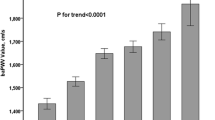Abstract
Background
Measurement of pulse wave velocity (PWV) is a useful approach for evaluating the severity of atherosclerosis in adults, and, in particular, the measurement of brachial–ankle PWV (baPWV) has been commonly reported as a simple and practicable method. We attempted to investigate how baPWV in healthy children changes with age and gender, in order to assess baPWV in children with risk factors for the early progression of systemic atherosclerosis.
Methods
We measured baPWV in 970 healthy Japanese children (500 boys and 470 girls), and set up the normal baPWV values of children on the basis of age and gender. We also performed linear regression analysis and step-wise multiple regression analysis for evaluating its correlation with baPWV and independent variables for baPWV in children.
Results
The values of baPWV in children were higher in boys than in girls, and baPWV increased with age in both genders. Age, blood pressure and heart rate (HR) were significant determinants of baPWV in both male and female subjects, while the obesity index had no correlation with baPWV.
Conclusion
On the basis of these results, we suggest that baPWV in children is largely influenced by age and gender, and that baPWV gradually increased with age in both genders.
Similar content being viewed by others
Abbreviations
- PWV:
-
Pulse wave velocity
- baPWV:
-
Brachial–ankle PWV
- ABI:
-
Ankle–brachial index
- BMI:
-
Body mass index
- SBP:
-
Systolic blood pressure
- DBP:
-
Diastolic blood pressure
- HR:
-
Heart rate
References
Ahimastos AA, Formosa M, Dart AM, Kingwell BA (2003) Gender differences in large artery stiffness pre- and post puberty. J Clin Endocrinol Metab 88:5375–5380
Avolio AP, Chen SG, Wang RP, Zhang CL, Li MF, O’Rourke MF (1983) Effects of aging on changing arterial compliance and left ventricular load in a northern Chinese urban community. Circulation 68:50–58
Brook GJ, Keidar S, Boulos M, Grenadier E, Wiener A, Shehada N, Markiewicz W, Benderli A, Aviram M (1989) Familial homozygous hypercholesterolemia: clinical and cardiovascular features in 18 patients. Clin Cardiol 12:333–338
Cheung YF, Brogan PA, Pilla CB, Dillon MJ, Redington AN (2002) Arterial distensibility in children and teenagers: normal evolution and the effect of childhood vasculitis. Arch Dis Child 87:348–351
Cole TG, Bellizzi MC, Flegal KM, Dietz WH (2000) Establishing a standard definition for child overweight and obesity worldwide: international survey. BMJ 320:1240–1243
Covic A, Mardare N, Gusbeth-Tatomir P, Brumaru O, Gavrilovici C, Munteanu M, Prisada O, Goldsmith DJ (2005) Increased arterial stiffness in children on haemodialysis. Nephrol Dial Transplant 21:729–735
Hirai T, Sasayama S, Kawasaki T, Yagi S (1989) Stiffness of systemic arteries in patients with myocardial infarction. Circulation 80:78–86
Krantz JS, Mack WJ, Hodis HN, Liu CR, Liu CH, Kaufman FR (2004) Early onset of subclinical atherosclerosis in young persons with type 1 diabetes. J Pediatr 125:452–457
Lehmann ED, Riley WA, Clarkson P, Gosling RG (1997) Non-invasive assessment of cardiovascular disease in diabetes mellitus. Lancet 350 [Suppl 1]:14–19
Lehmann ED, Hopkins KD, Rawesh A, Joseph RC, Kongola K, Coppack SW, Gosling RG (1998) Relation between number of cardiovascular risk factors/events and non-invasive Doppler ultrasound assessment of aortic compliance. Hypertension 32:565–569
London GM, Gurein AP, Pannier B, Marchais SJ, Stimpel M (1995) Influence of sex on arterial hemodynamics and blood pressure. Role of body height. Hypertension 37:1374–1380
McDonald DA (1994) The elastic properties of the arterial wall. In: McDonald DA (ed) Blood flow in arteries, 2nd edn. Edward Arnold, London, pp 238–282
McGill HC Jr, McMahan CA, Herderick EE, Malcom GT, Tracy RE, Strong JP (2000) Origin of atherosclerosis in childhood and adolescence. Am J Clin Nutr 72(Suppl):1307S–1315S
Munakata M, Ito N, Nunokawa T, Yoshinaga K (2003) Utility of automated brachial ankle pulse wave velocity measurements in hypertensive patients. Am J Hypertens 16:653–657
National High Blood Pressure Education Program Working Group on High Blood Pressure in Children and Adolescents (2004) The fourth report on the diagnosis, evaluation, and treatment of high blood pressure in children and adolescents. Pediatrics 114:555–576
Sawabe M, Takahashi R, Matsushita S, Ozawa T, Arai T, Hamamatsu A, Nakahara K, Chida K, Yamanouchi H, Murayama S, Tanaka N (2005) Aortic pulse wave velocity and the degree of atherosclerosis in the elderly: a pathological study based on 304 autopsy cases. Atherosclerosis 179:345–351
Senzaki H, Akagi M, Hishi T, Ishizawa A, Yanagisawa M, Masutani S, Kobayashi T, Awa S (2002) Age-associated changes in arterial elastic properties in children. Eur J Pediatr 161:547–551
Tomiyama H, Yamashina A, Arai T, Hirose K, Koji Y, Chikamori T, Hori S, Yamamoto Y, Doba N, Hinohara S (2003) Influences of age and gender on results of noninvasive brachial–ankle pulse wave velocity measurement—a survey of 12517 subjects. Atherosclerosis 30:303–309
Toto-Moukouo JJ, Achimastos A, Asmar RG, Hugues CJ, Safar ME (1986) Pulse wave velocity in patients with obesity and hypertension. Am Heart J 112:136–140
Tounian P, Aggoun Y, Dubern B, Varille V, Guy-Grand B, Sidi D, Girardet JP, Bonnet D (2001) Presence of increased stiffness of the common carotid artery and endothelial dysfunction in severely obese children: a prospective study. Lancet 358:1400–1404
van Popele NM, Grobbee DE, Bots ML, Asmar R, Topouchian J, Reneman RS, Hoeks AP, van der Kuip DA, Hofman A, Witteman JC (2001) Association between arterial stiffness and atherosclerosis: the Rotterdam Study. Stroke 32:454–460
Yamashina A, Tomiyama H, Takeda K, Tsuda H, Arai T, Hirose K, Koji Y, Hori S, Yamamoto Y (2002) Validity, reproducibility, and clinical significance of noninvasive brachial–ankle wave velocity measurement. Hypertens Res 25:359–364
Author information
Authors and Affiliations
Corresponding author
Rights and permissions
About this article
Cite this article
Niboshi, A., Hamaoka, K., Sakata, K. et al. Characteristics of brachial–ankle pulse wave velocity in Japanese children. Eur J Pediatr 165, 625–629 (2006). https://doi.org/10.1007/s00431-006-0135-y
Received:
Accepted:
Published:
Issue Date:
DOI: https://doi.org/10.1007/s00431-006-0135-y




